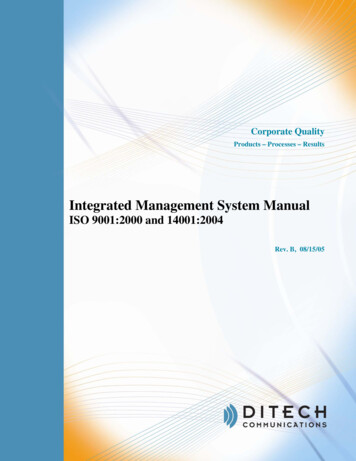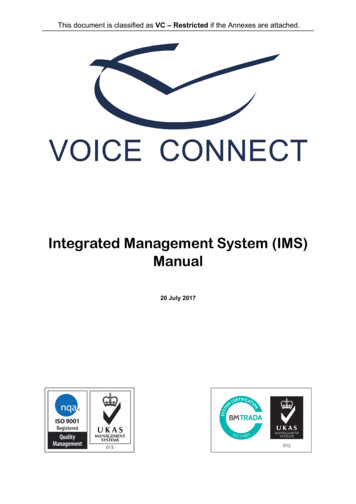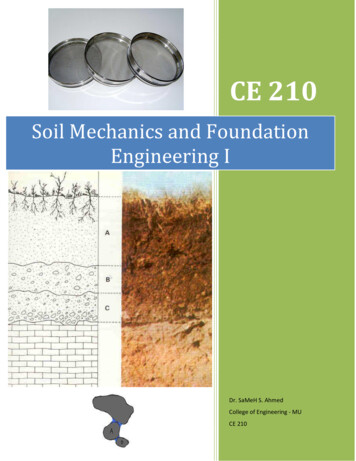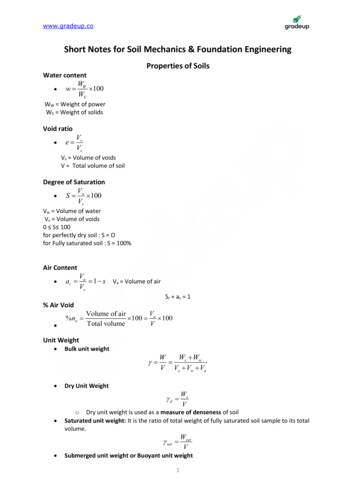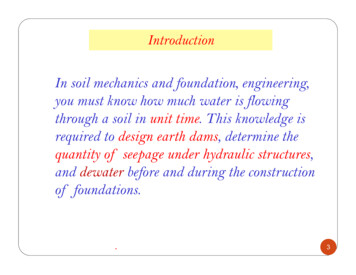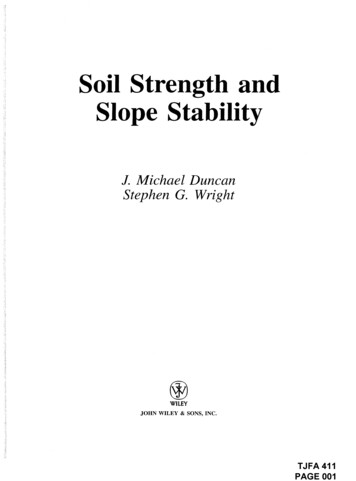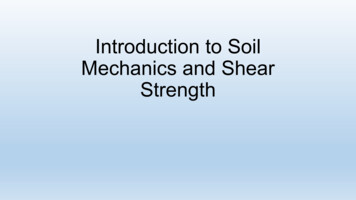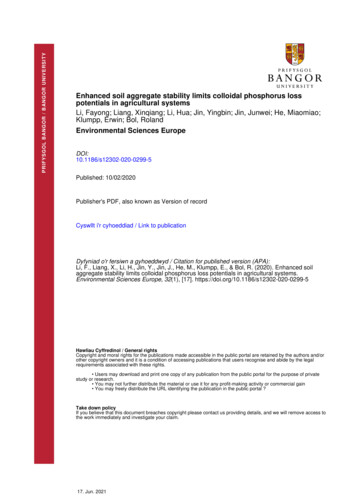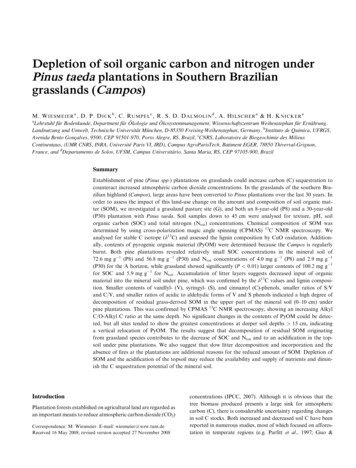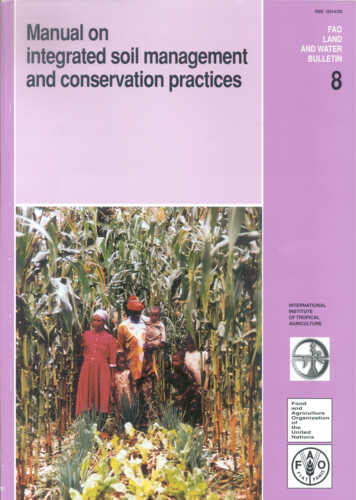
Transcription
Manual on integrated soil management and conservation practicesiiiForewordThe processes of land erosion in various regions of Latin America and Africa have their origin insocial, economic and cultural factors that translate into the over-exploitation of the naturalresources and the application of inadequate practices for the management of soils and water.The consequences of this are damage to much of the agricultural land, with detrimental effectson food production for the growing population in these continents.Over the last few decades, many efforts have been made to stop the degradation of agriculturalland but the process of adoption of new conservationist technologies by the farmers is still slow.Furthermore, the availability of technical personnel trained for this change is limited.The technological strategies that have been developed for the management and conservation ofsoil and water sometimes are not adapted for the beneficiaries, because they could notparticipate in the processes of the diagnosis, planning and execution of the actions. In addition,the promotion of conservation tillage systems and practices that were not adapted to specificregional requirements has created credibility problems with the farmers probably since they hadbeen developed in other places and introduced without a correct diagnosis of the local situation.The development of technologies that guarantee the maintenance of agricultural land productivityin Latin America and Africa is a challenge that both technicians and farmers must face throughcollaborative research and field work in the farmers’ own environments and conditions. Thisincludes identification of the problems of management and conservation of soils and water and agreater emphasis on the evaluation of the potential for systems of conservation tillage adapted tothe specific conditions of each region.This Manual has been put together with the objective of assisting actions by the diverse groupsof human beings who intervene in the conservation of the natural resources, particularly soil andwater resources and in the context of each continent, country, region or zone. The Manual bringstogether a collection of concepts, experiences and practical suggestions that can be of immediateuse for identifying problems and for formulating, executing and evaluating actions so as to benefitand to improve the productivity and conservation of soil and water resources.This Manual is based on the Training Course for Soil Management and Conservation, focusedparticularly on efficient tillage methods for soil conservation, held at the International Institute ofTropical Agriculture (IITA) in Ibadan, Nigeria from 21 April to 1 May 1997. It was jointlyorganized by IITA and FAO with the participation of specialists from both national andinternational organizations.The publication serves as a guide that will allow technicians and farmers to jointly discover waysto solve the problems and the limitations posed by land degradation in Latin America and Africa.Participatory action by technicians and farmers will be the basis for success in benefiting theseregions. It is hoped that the Manual will help to attain the ultimate objective, which is to improvethe productivity of the soils and water in a rapid and efficient manner.
ivAcknowledgementsThe present Manual is based on the Training Course on Soil Management andConservation with Special Emphasis on Conservation Effective Tillage Methodsjointly organized by José Benites, Land and Plant Nutrition Management Service(AGLL) and Theodor Friedrich, Agricultural Engineering Branch (AGSE), FAOand the International Institute of Tropical Agriculture (IITA) in Ibadan, Nigeria.The training course would not have been possible without the active support of theDirector General of IITA, Lucas Brader, as well as his staff, in particular R. Booth,J. Gulley, R. Zachmann, R. Carsky, Y. Osinubi, B. Akisinde, G. Kirchof and G.Tian and we would like to express our gratitude for this support. We would furtherlike to thank the authors of the different papers for their collaboration in thispublication, particularly Elvio Giasson, Leandro do Prado Wildner, José Barbosa dosAnjos, Valdemar Hercilio de Freitas and Richard Barber, as well as Cadmo Rosell,John Ashburner, Robert Brinkman and R. Dudal for assisting with the editing of thedifferent language versions.Special thanks are due to Lynette Chalk for her efficient preparation of the text andformatting of this document and Riccardo Libori for his elaboration of the graphics.
Manual on integrated soil management and conservation practicesvTable of contentsPageFOREWORDiiiA CKNOWLEDGEMENTSiv1.INTRODUCTIONObjectivesStructure and content2.KEY ENVIRONMENTAL AND SOIL FACTORS INFLUENCING PRODUCTIVITYAND MANAGEMENTTopographyRainfallSoil limitationsSoil conditionsProductivity12255568123.GENERAL PRINCIPLES FOR THE DEVELOPMENT OF SOIL MANAGEMENT STRATEGIESObjectives of soil management for agriculturePrinciples for the development of soil management practices1313144.CONCEPTS AND OBJECTIVES OF TILLAGE IN CONSERVATION FARMINGWhy conserve the soil?The concept of integrated management – conservation farmingTechnical tillage parameters272728325.TILLAGE IMPLEMENTSMoldboard ploughDisc implementsChiselsSpike-toothed tines – levellers and harrowsRotary cultivators (rotavators)RollersDirect drilling - zero tillage37373840424242436.IMPLEMENTS AND METHODS FOR THE PREPARATION OF AGRICULTURAL SOILObjectives of soil preparationImplements for soil preparation4546477.EFFECT OF TILLAGE ON SOIL PHYSICAL PROPERTIESCauses of physical soil degradationStages in the physical degradation of soilPrincipal physical characteristics affected by tillage515152528.PRINCIPAL TILLAGE METHODSTerminology, definitions and classification of tillage systemsPrincipal types of tillage system555557
viPageStrip tillage or zonal tillageRidge tillageCombined tillage and seeding systemsSubsoiling9.LAND USE ACCORDING TO ITS CAPABILITYLand evaluation69707576818110. SOIL COVER8711. CONTOUR FARMING9112GREEN MANUREConceptFunctions of green manureCharacteristics to consider when selecting types of green manureCharacteristics of green manureManagement of green manureEffects of green manure on the soil properties93939394959910213. PHYSICAL BARRIERS FOR THE CONTROL OF RUNOFFTerracingSafe waterways11311312014. GULLY CONTROLConceptGully dimensionsMeasures for control and stabilization12512512512615. RAINWATER CAPTURE AND IRRIGATIONPrincipal factors affecting the establishment of systems for rainwater captureMethods for in situ rainfall captureIrrigation aspects13113113213716. SELECTION OF ALTERNATIVE TECHNOLOGIESInformation sources concerning alternative technologiesTechnology selection on the basis of farmers’ circumstancesTechnology selection on the basis of environmental considerationsTechnology selection on the basis of “Problem – Solution” relationshipsReflections concerning the selection of soil management technologies14314314314514616617. PARTICIPATORY PLANNING IN THE EXECUTION OF SOIL MANAGEMENT PROGRAMMESMicro-catchment areas as planning unitsImplementation of programmes and projectsObjectives of a programme and projectEnthusiasm as the driving force for developmentSuccess – the source of enthusiasmParticipation - the road to followDestructive participationHow to improve constructive participationHow to increase participationSome criteria for selecting an appropriate technology169170171171172172173173174174178
Manual on integrated soil management and conservation practicesviiPageParticipating with the rural families in planning the soil management practicesCommunity planningMaking thematic mapsEstablishing priorities for the actions to be undertaken in the microcatchment basinFormulation of projectsConservation farm planningCommunity mappingImplementation of soil management plans179180181182182183183184BIBLIOGRAPHY187A NNEXES1. Comparison of field work rates with tillage implements2. Purchase and maintenance costs for tillage implements3. Notebook for participatory planning in our community197197199201
viiiList of tablesPage1.Training course on “Methods of soil management and conservation: efficient tillagemethods for soil conservation”42.Mulch cover and soil loss from two simulated rainfalls153.Average effect of the nature and orientation of crop residues on the erosion of asandy loam soil by wind at a uniform velocity15Effects of mulch cover and the type of tillage on the amount of moisture (mm) storedin 120 cm soil depth. Faizabad, India17Types of tillage and their effect on the moisture, temperature and rate of emergencefor cowpea and soybean.176Application of mulch and the quantity of earthworm casts187Effects of cover crops on infiltration rates with and without earthworm activity198.Straw production and the relationships of C/N and of the grain/straw weight for annualcrops, Santa Cruz, Bolivia21Effects of deep tillage on some physical properties and on root development in acompacted soil2410.Work rates per unit area needed to carry out a selection of agricultural tasks on the farm4611.Effect of tillage systems on the soil density and porosity5312.Quantity of residues remaining on the soil after different tillage treatments5613.Tillage systems classified according to the degree of disturbance to the soil and the surfacecover of residues57Moisture content, residue cover and maize yield for four tillage systems in Oxford, NorthCarolina, USA6215.Working characteristics of the chisel plough for stubble6316.Effect of tied ridges on the yields of different crops in Tanzania7117.Effects of tillage on runoff and soil loss for soils cultivated with maize in Nigeria7218.Guide-table for definition of the classes and sub-classes of land use capability for group1 soils of the Lageado Atafona catchment basin, Santo Ângelo, Brazil864.5.9.14.
Manual on integrated soil management and conservation practicesixPage19.Evaluation of the effect of increasing the quantity of maize residues in the soil cover onthe runoff flow, the runoff velocity and the total soil losses88Effect of the annual crop type on soil losses by erosion. Average rainfall of 1 300 mm anda slope between 8.5 and 12.8 percent89Effect of the type of perennial crop or vegetation on erosion losses of soil. Weightedaverages for three soil types in the State of São Paulo, Brazil89Losses of soil and water during the growth cycles of soybean, wheat, maize andcotton in a red dystrophic latosol soil and a slope of 8 percent89Total soil losses in plots with a 7.5 percent slope for a Red-yellow podsolic soil undersimulated rainfall of 64 mm/h and with different quantities of crop residues9024.Chemical composition of some residues used as a dead vegetative cover9025.Percentage of soil cover as a function of the management of residues from different crops9026.Effect of management and conservation practices on erosion losses under annual crops9127.List of the main species used as green manure and soil cover9628.Production of biomass and analysis of the nutrients in the vegetative cover of winter greenmanure species evaluated at the CPPP106Nutrient content of the components (stems and leaves) of summer cycle annual specieswith a potential for use as a green manure, soil cover and for soil recovery106Nutrient content of the stems and leaves of winter cycle, semi-perennial and perennialspecies with a potential for use as a green manure, soil cover and for soil recovery107Effect of different species of green manure for controlling nematodes in a dark-red latosolsoil (LE) from Cerrado108Allopathic effect of crops and species used for green manure (Bidens alba), on thegermination of seeds from a selection of weeds10933.Length, slope and drop in level for graded terraces11934.Recommended spacing for bench terraces12235.Construction recommendations for the spacing of staked structures in gullies12736.Monthly rainfall recorded at Petrolina, PE, Brazil for the period 1985 – 199413237.Values of the Tank Coefficient for a Class A tank (Kp) for estimated values of the referencerate of evapo-transpriration141Limitations, causes and elements of possible soil management solutions14720.21.22.23.29.30.31.32.38.
xPage39.Straw production by different crops, and classification in terms of an index of the degreeof organic matter supply to the soil156List of crop rotations and sequences that are not recommended for the sub-humid zonesof Santa Cruz, Bolivia15741.Species that are used or have been found to be promising as live barriers16442.Guide to the selection of soil conservation practices for different crops and slopes inEl Salvador16540.
Manual on integrated soil management and conservation practicesxiList of figuresPage1.Effects of cover on the reduction of splash erosion162.Relationship between soil cover, slope and the erosion risk163.Infiltration rates in plots with and without mulch174Relationship between the organic matter in the first 15 mm of soil and thequantity of crop residues applied over 5 years in Georgia18Distribution of organic matter in the soil after 10 years of zero tillage andconventional tillage18A simplified model to calculate the quantity of additional forage required tosatisfy the needs of livestock and for soil protection207.Method of ploughing in strips with animal traction478.Groundnut lifting share used for ploughing in strips or bands489.System for weeding (hoeing) with animal traction4810.Ridging with animal traction4811.Manual planter for non-delinted cotton seed4912.The tillage triangle5813.Stubble mulch chisel plough6114.Spring-tined cultivator (Vibro-Cultivator) equipped with a levelling blade and along-fingered rake6115.Stubble mulch cultivator6116.The flexible tined chisel plough "Vibroflex"6417.Types of cultivator point6518.Long-fingered rake6619.Spike-toothed harrow6620.Lightweight cage rolls6621.Heavy clod-breaking roll6756
xiiPage22.Row-crop cultivator equipped with a band sprayer6823.Ripper6824.Se
and to improve the productivity and conservation of soil and water resources. This Manual is based on the Training Course for Soil Management and Conservation, focused particularly on efficient tillage methods for soil conservation, held at the International Institute of Tropical Agriculture (IITA) in Ibadan, Nigeria from 21 April to 1 May 1997. It was jointly

